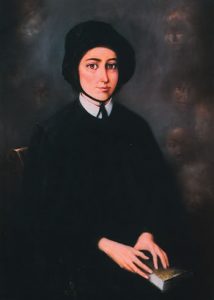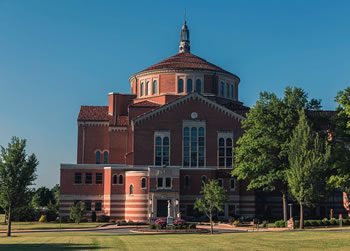St Elizabeth Ann Seton, s.c.
Widow, foundress and educator
When Pope John XXIII beatified Elizabeth Seton in March 1963, he said, “In a house that was very small, but with ample space for charity, she sowed a seed in America which by Divine Grace grew into a large tree.” Twelve years later, she became America’s first native born saint and added substantial growth to that tree which has continued ever since.
Elizabeth Ann Bayley Seton was born in New York in 1774 to a wealthy, influential Episcopalian family. When she was three, her mother died and although her father later remarried and had another seven children, the marriage ended in separation. Elizabeth and her older sister Mary were never accepted by their stepmother so when their father travelled abroad for his work, the girls stayed with their aunt and uncle in New York.
 She grew into a confident, vivacious young woman who shone at the parties and balls she attended in the circles in which she moved. She was also very intelligent and was naturally drawn to poetry, music and nature. When she was 19 she met and married William Seton, a match made in heaven if her diary entry as a newly-wed is anything to go by. “Married,” she wrote, “my own home at twenty – my happiness is complete.”
She grew into a confident, vivacious young woman who shone at the parties and balls she attended in the circles in which she moved. She was also very intelligent and was naturally drawn to poetry, music and nature. When she was 19 she met and married William Seton, a match made in heaven if her diary entry as a newly-wed is anything to go by. “Married,” she wrote, “my own home at twenty – my happiness is complete.”
Elizabeth and William had five children although only two would live to old age: two died in their teens and one at age 25. When William’s father died four years after their marriage, the couple had to take responsibility for the family importing business along with caring for William’s seven younger half-siblings. Three years later the struggling Company went bankrupt and with the loss of their home and William’s failing health, they set sail, with their eldest daughter Anna Maria to stay with friends in Italy. The journey was uneventful until they reached the Italian port of Livorno where they were quarantined for almost six weeks due to a yellow fever outbreak in New York. Elizabeth spent much of her time nursing the sick and the dying as well as tending to the needs of her family.
Two weeks after joining their friends, William died of tuberculosis. He was 37 years old. In the following months before returning to New York, Elizabeth drew closer to God through prayer and through her friends who introduced her to the Catholic faith. She was particularly interested in the Real Presence in the Eucharist and formed a great devotion to Our Lady; the more she studied, the deeper involved she became – though not without much inner conflict. Despite the opposition she constantly faced among family and friends on her return to America, Elizabeth persevered and on the 14th of March 1805 she was received into the Catholic Church.
Over the next few years a variety of teaching jobs ensued until in 1808 Elizabeth was invited by the Sulpicians (Society of Saint Sulpice) to run a school in Baltimore, Maryland, for children’s religious education. This would be the beginning of the parochial school system in the United States. While there, the Sulpicians revealed their plan for an Order based on the principles of the Daughters of Charity of Paris and gradually their small community began to grow. On 25 March 1809, Elizabeth became Mother Seton as she alone pronounced vows of chastity and obedience for one year.
... the first end I propose in our daily work is to do the will of God; secondly, to do it in the manner he wills it, and thirdly to do it because it is His will.
Three months later Elizabeth and a handful of women who had joined her religious order arrived in Emmitsburg, Maryland, where almost 300 acres of land had been donated to them for the sole use of a Christian educational programme. On the 31st of July 1809 the Sisters of Charity of St Joseph was formed. They lived in temporary accommodation while awaiting the completion of their permanent home which would have a chapel, infirmary, refectory, 30 cells, parlour, school and workroom. In February 1810, with the move completed, Mother Seton and her Sisters opened the first free Catholic girls’ schools run by sisters in America. St Joseph’s Free School educated local poor and disadvantaged girls and was followed by St Joseph’s Academy in May of that year. Boarders attended the Academy and their fees helped with the running of the complex. Catholic education now had a foothold in America.
In 1811 the rules of the Daughters of Charity originating with St Vincent de Paul were formally adopted for Elizabeth’s order. Two years later 17 more Sisters of Charity made annual vows of poverty, chastity, obedience and service of the poor for the first time. In 1814, a group of Sisters were sent to Philadelphia to run the first Catholic orphanage in the country followed by another orphan asylum in New York in 1817.
Tuberculosis had dogged Elizabeth for many years, just as it had other members of her family. It finally ended her life on the 4th of January 1821 at the age of 46. She believed passionately that, not only should education be accessible to all people equally - including the poor and needy – but that Catholic teaching should also be available. This, in an era that did not recognise the concept. Because of that she is often referred to as the patron saint of Catholic schools.
At the time of her death, there were establishments across America under the banner of the Sisters of Charity. Free schools, orphanages, hospitals and boarding schools were set up in Philadelphia, New York, Massachusetts, Ohio, Virginia, Missouri and Louisiana among others. There are now hundreds of educational and social services centres world-wide that have grown from those early seeds. In a tangible sense, these are the legacies Elizabeth Seton left but through her writings we learn of her spirituality and her philosophies and we see there is so much more to this extraordinary woman.
Elizabeth had a deep conviction that to listen for God’s will and act upon it was the most important thing she could do. “What was the first rule of our dear Saviour’s life?” she once said. “You know it was to do the Father’s will. Well then, the first end I propose in our daily work is to do the will of God; secondly, to do it in the manner he wills it, and thirdly to do it because it is His will.” Everything revolved around this belief and all she accomplished proved she truly took it to heart. Throughout all the tragedies and heartaches she suffered in her life, she hung on to her faith in God. He was the source of her strength: “How sweet, the presence of Jesus to the longing, harassed soul! It is instant peace, and balm to every wound.”
Today, visitors from all over the world visit the home where the saint lived for twelve years before her death in 1821 and where her remains now lie. The National Shrine of St Elizabeth Seton in Emmitsburg, Maryland, is a fitting reminder of a remarkable woman and all she achieved in her lifetime.
Elizabeth Seton was canonised by Pope Paul VI on the 14th of September 1975 who spoke of “the intention of honouring the land and the nation from which she sprang forth as the first flower in the calendar of saints.” Her feast day is the 4th of January. 


 Entries(RSS)
Entries(RSS)